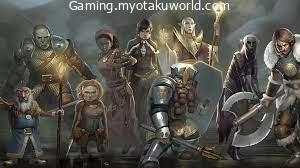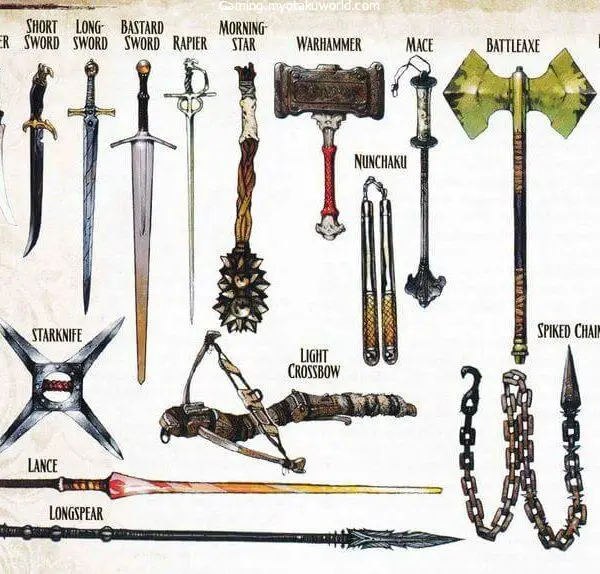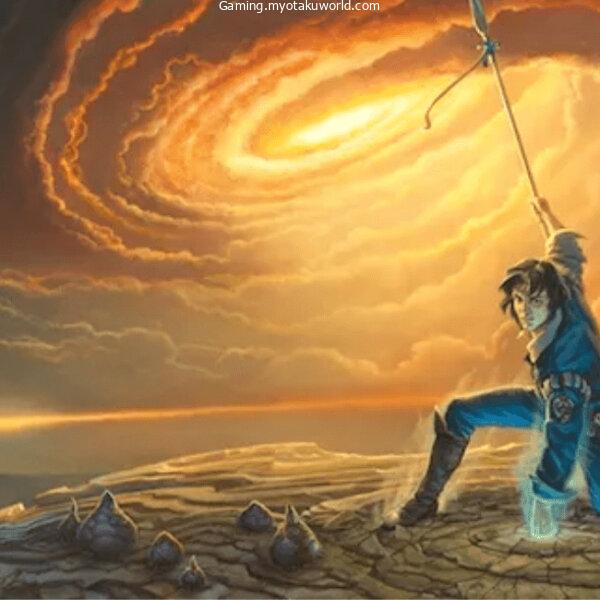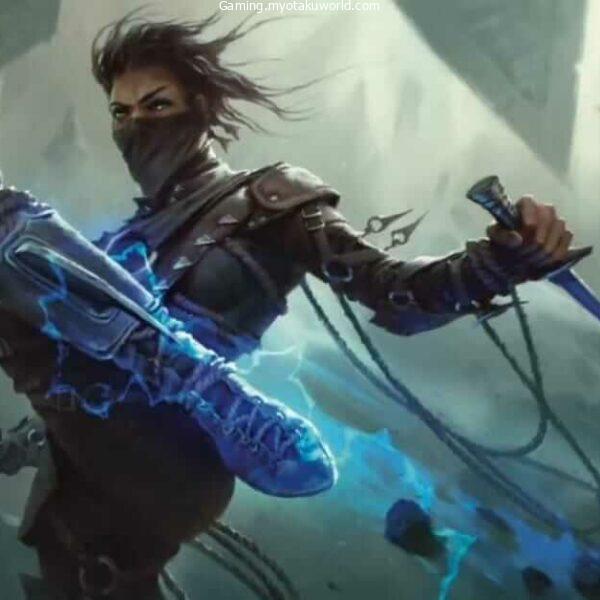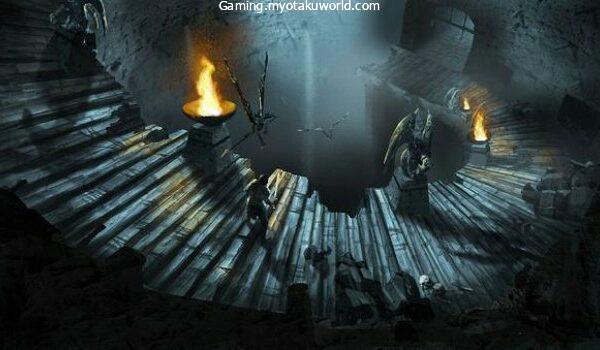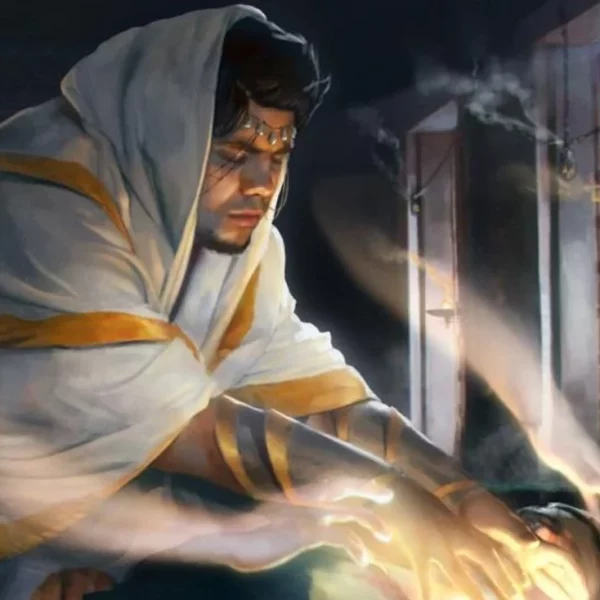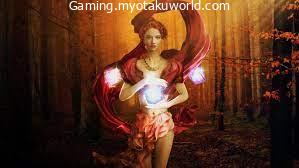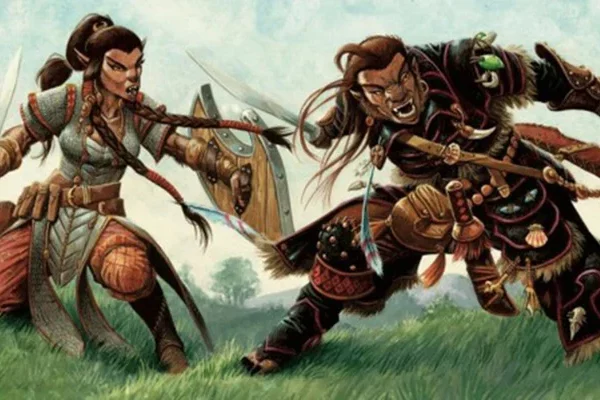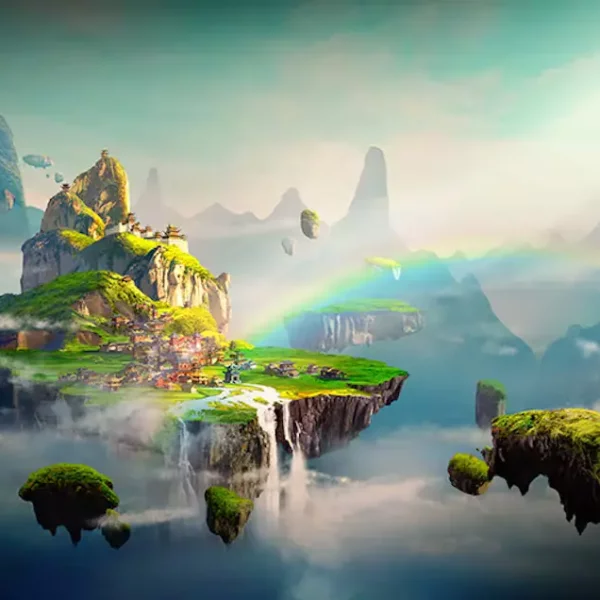Many races populate D&D’s worlds, from gentle elves to tough dwarves.
When creating a character, you choose the race that you wish to portray.
You will also choose a subrace, which is a subset of the overarching race.
What is the difference?
How do you choose which one to choose?
Let’s get to it.
- Landscape Change
- Aarakocra
- Aasimar
- Bugbear
- Centaur
- Changeling
- Custom Lineage
- Dhampir Lineage
- Dragonborn
- Dwarves
- Elves
- Firbolg
- Genasi
- Gith
- Gnome
- Goblin
- Goliath
- Half-Elf
- Half-Orc
- Hexblood Lineage
- Hobgoblin
- Human
- Kalashtar
- Kenku
- Kobold
- Leonin
- Lizardfolk
- Loxodon
- Minotaur
- Orc
- Reborn Lineage
- Satyr
- Shifter
- Simic Hybrid
- Tabaxi
- Tiefling
- Tortle
- Triton
- Vedalken
- Verdan
- Warforged
- Pureblood Yuan-Ti
- FAQs
- Final Words
Landscape Change
Over the years, the world of D&D has changed a lot. This is even true for the 5th edition. Tasha’s Cauldron of Everything, the sourcebook, introduced rules that allow you to customize your origin.
This gave rise to a wide range of possibilities for creating characters that are interesting and original without compromising on optimizing.
If your DM permits customization, which they likely will, you can change the ability score increases for your race and any other ability score that suits your character. You can also swap between skill and weapon proficiencies.
D&D can be played in many worlds, so there are not only mechanical differences. These worlds can be official settings like Ravnica or Eberron.
Other settings can be created by your dungeon master. Your DM might not use the Wizards of the Coast lore so it is a good idea to speak to your DM about the races within their setting.
Let’s now look at the official races.
Aarakocra

Aarakocra is also known as bird folk and is a humanoid creature that has the wings, feathers, talons, and heads of large peregrine birds.
Aarakocra is native to the Elemental Planes of Air. The nests they have on Material Plane serve as outposts throughout the world.
The majority of Aarakocra keep to themselves and their tribes. They prefer to fly through the skies for hours or even days than to interfere in the affairs of the rest.
One of the key benefits of playing as an Aarakocra is flight. You can fly like a bird from level 1 and make it easy to overcome any challenges.
Aasimar
Aasimar, who are people born with a touch of the celestial, can be transformed into celestial champions.
Aasimar is linked to a divine entity who helps them to follow their dreams and follow a prescribed path.
Despite this, aasimar can make their own decisions and become agents of evil rather than follow their path.
There are three subraces of Aasimar, each one with its own relationship to the divine weight thrust upon them.
Protector aasimar protects the weak from evil forces and uses their blessing to do so in a noble way.
Scourge aasimar is a group of fanatics who are determined to eradicate evil from the world.
Fallen aasimar have dark powers, or forsaken their path. Their inner light is replaced by a shadow.
Bugbear

Bugbears, ferocious goblinoids, were bred to fight. They were originally monsters in Dungeons and Dragons but became playable after being bred for battle.
They are strong and covered in hair, with a powerful build. Hruggek is a plane-of-Acheron being that bugbears worship.
They believe they will be able to fight alongside their god when they die. They are determined to prove their worth by defeating all enemies in battle.
Centaur
Centaurs are featured in the campaign-setting books Guildmaster’s Guide to Ravnica, and Mythic Odysseys of Theros.
Centaurs appear in fantasy works as humans from the waist upwards and as horses from the neck down.
D&D’s centaurs look more like humans than horses. They are only six to seven feet tall. They are the fastest race due to their horse bodies.
The centaur was the original non-humanoid humanoid player race. Your creature type is now fey. This makes you immune to spells such as Charm Person and Hold Personne.
Changeling

The Guildmaster’s Guide to Ravnica describes changelings as humans who can shapeshift. Changelings, in their true form, are pale and colorless.
They look like a blank canvas. A changeling may create or develop a persona to express a certain emotion.
Multiple changelings may share the same persona, such as a uniform.
Custom Lineage
Custom lineage introduced by Tasha’s Cauldron of Everything This allows you to make your character look and feel exactly the way you want.
You can choose what you look like, and then use the custom lineage traits for your traits.
Dhampir Lineage

The Dhampir lineage refers to humanoid beings who are tied to the undead and suffer from a vampiric desire for blood or flesh.
Lineages, which are heritage traits that any race can have, were published in Van Richten’s Guide to Ravenloft. You have the option of creating a character for dhampir or becoming one during the game.
A Dhampir is a vampiric creature that does not need to breathe, can walk on walls, and has vampiric fangs to eat the lives of its targets. They can deal damage, heal, or aid the dhampir.
Dragonborn
The Dragonborn are humanoid dragon-like creatures. While some humanoid races are spawned out of the union between humans and other races, the Dragonborn is not one of them.
Dragonborn were created from eggs from dragons and then magically created their race from them. The Dragonborn is a dragon-like race with heads and scales but without wings or tails.
Each Dragonborn can trace their lineage back to a specific type of dragon, such as black, red, or copper.
This lineage determines the Dragonborn’s innate breath weapon and damage resistance.
Dragonborn Variants
Two Dragonborn variations were introduced in the Explorer’s Guide to Wildemount. The Dragon Blood is the first.
The Draconbloods are long-tailed and once conquered Exandria’s world. They also enslaved Ravenite Dragonborn. They are now in decline and may long to be in control.
The Ravenite is the second Dragonborn variant. They were enslaved with dragon blood until their freedom was achieved.
Both ravenites and dragon blood don’t have as much damage resistance as the original Dragonborn.
Dwarves

Dwarves are strong, traditional, and hardy. They build kingdoms in the mountains and then mine the interior for fuel to power their cities.
They are well-known for their strength, drinking ability, and amazing beards. It’s not surprising that Gimli, the protagonist of Lord of the Rings, is the most iconic dwarf.
She is hardy, hardworking, and slow. Dwarves live for 400 years and can still respect their traditions.
There are three subraces of dwarves that can be distinguished by their location in the world. Hill dwarves are the first, and they live in hills.
They are resilient and intuitive. Mountain dwarves are from higher elevations and can adapt to living in difficult terrain. They also get two +2 ability scores increases.
The Duergar were a group of dwarves who were lured and enslaved underground by mind flayers, preying on their desire for great treasure.
After years of torture and psychic alterations, the duergar finally rebelled and turned against their god. They now live in the Underdark as dark reflections of the surface-dwelling Dwarves.
Elves
D&D’s elves are the creations of Corellon, the divine being who is constantly changing and who fought the Grummsh orc god. Corellon’s blood was the blood of the first elves.
Corellon was betrayed and beaten by Lolth, one of the first elves. The race of elves split. After the split, the elves fled to the Feywild, where they became humanoids.
The Feywild’s graceful elves live in isolation from the rest of the world and love everything that reminds them of their past.
Their skin color ranges from copper to bronze, obsidian to slender. The Player’s Handbook describes them as being haughty. This is a way to say that they believe they are better than everyone else.
The elf is quick and perceptive, and they don’t require sleep. They can’t even be put to sleep by magic.
They can instead spend up to four hours in a trance and enjoy the effects of eight hours of sleep.
There are many different sub-races of Elf, with each one having a slightly different personality.
Six subraces of elf are available in D&D. They have some magic knowledge and are not likely to mix with other races.
Wood elves can be found in large forests, and they are agile and can navigate the world with ease and wisdom.
Following the conflict with Corellon, the elf god Lolth fled into the Abyss and her followers were exiled to the Underdark, a dark place deep beneath the surface of the earth.
These elves, also known as dark elves, absorbed the Underdark’s twisted nature for centuries. Drow has evolved to have dark skin, pale hair, and eyes.
The elves were known to travel to many other realms in the beginning. Eladrin is for those who have never left the feywild. There are four types of eladrin.
Each one is associated with a season. Sea elves are elves who have found their home in the vast oceanscapes where they traveled. The Shadar-Kai are elves that traveled to Shadowfell to serve the Raven Queen.
Firbolg

Firbolgs is a gentle race of giant-kin that live in isolated tribes deep within the natural realms.
They are gentle guardians of the natural world and have druidic talents. They look after the land and do not harm it.
Genasi
Genasi is the offspring of mortals and genies. The power of an elemental plane is imbued in genies by the native genies. There are four types of Genasi, which are air, earth fire, and water.
Each type of genasi has physical characteristics that reflect its element. Fire genasi’s hair looks like fire, while air genasi are always caught in the breeze.
Each genasi can also cast spells that use their element innately.
Gith

The gith, an alien race, were for centuries enslaved and controlled by mind flayers. They were led to freedom by a warrior named Gith, but soon the victory was marred by a conflict between two factions that created the githyanki or githzerai.
Gith is believed by the Githyanki, and they have turned into a militaristic society that seeks to kill their enemies.
Vlaakith was appointed lich-queen to replace Gith when she died. Githyanki lives on the Astral Plane in the city of Tu’narath.
Githzerai believed Gith, their liberator was creating another type of slavery after they were freed.
They live a strict monastic life on the plane Limbo. Their psionic abilities are powerful enough to create an immovable stronghold from the chaos of Limbo.
Gnome
Gnomes love life and are happy-go-lucky pranksters. Gnomes are about three feet tall and live in close-knit communities on hilly, wooded land.
Most gnomes are proud of their smiles and don’t hide how they feel. Many gnomes are skilled tinkerers and great wizards.
There are three types of gnomes. Forest gnomes, who are secretive and elusive, live in the woods and are seldom seen by other people.
Rock gnomes are inventors and tinkerers. Svirfneblin, also known as deep gnomes, are gnomes who live under the Darkness. Deep gnomes, unlike the duergar or drow, are not evil gnomes who live in the Underdark.
Goblin

Volo’s Guide to Monsters has a playable race called the Goblins. Goblins are greedy, selfish creatures that live in dark caves and dungeons.
Goblins are great infiltrators or scouts due to their size and sneakiness.
Goliath
Goliath is a mountain-dwelling tribe of men who are large and determined to beat each other in every way.
Goliaths are strong and resilient despite the harsh environment they live in.
However, they are also fair-minded and have a strong sense of fair play. Goliaths are resilient and can adapt to cold and high-altitude environments.
Half-Elf

Half-elves can be described as half-human and half-elf. They live in the middle of two worlds, humans and elves.
Although they may have the pointed ears of elves, half-elves look just like humans to an elf.
Half-elves have an ability score that increases to three abilities. This makes them more powerful than other races.
They also inherit the Fey ancestry, which allows them to resist charm effects more easily.
Some elves can trace their elfish lineage back to specific types of elves. Half-elves can inherit some traits from their ancestors through the variant half-elf options in the Sword Coast Adventurer’s Guide.
An example of this is an aquatic half-elf who might be born with innate swimming skills.
Half-Orc
Half-orcs can be described as the offspring of humans and orcs. Although orcs and humans are often enemies, there have been some peaceful agreements between them that can be signed and sealed by a marriage.
Half-orcs are usually grey or green with severe underbites and jutting teeth. They are strong and savage creatures and proudly wear their battle scars.
Halflings are small, friendly creatures that have simple needs and cheer. They are approximately 3 feet tall.
Halflings prefer peace over the chaos of war. Halflings prefer agricultural shire communities to kingdoms.
Halflings can be described as the same thing as hobbits from the Lord of the Rings. The Wizards of the Coast do not own the right to the term “hobbit” and therefore cannot name them.
There are three types of halflings. Halflings that are lightfooted are more common and smaller than halflings that are more elusive.
Stout halflings, which are more like dwarves in their nature, are tougher creatures. Ghosts halflings can trace their heritage back to an ancient war between halfling tribes.
They prefer small, isolated communities and are distrustful of outsiders. Ghost halflings possess the natural ability to communicate telepathically.
Hexblood Lineage

Van Richten’s Guide to Ravenloft identifies the second lineage as the hexblood.
Hexbloods are creatures that have been infused with witchcraft and fey energy, often under the influence of a frightening hag.
Hexbloods can create tokens from teeth or nails and communicate telepathically with their bearers. They can also see and hear the token.
Hobgoblin
The Hobgoblins are a goblinoid species of large, dark-skinned, goblinid creatures.
Although they look similar to goblins, hobgoblins are a race of orcs who love war and have incredible martial prowess.
Human
The most widespread race in D&D is the human, which can be found in nearly every corner of the globe. There are many different races of humans, but they all share the same traits.
The only race that gets a bonus on all abilities is the human race. This makes them a master of all trades, but not naturally inclined toward any one specialty.
A variant human, also known as “human”, sacrifices some of its ability score to gain access to a skill proficiency or feat.
Kalashtar

Kalashtar is a half-human, half-spirit race. Eberron: Rising From the Last War features kalashtar, who appear as aliens in their natural world because they can’t shake their connection with a spirit from the planes of dreams.
They are physically more attractive because of their connection with the spiritual. They also have basic psychic abilities and immunity to psychic damage.
Kenku
The Kenku are a notorious race of humanoid, raven-like creatures. The kenku are believed to have betrayed their deity and lost their wings, creativity, and voice.
Many choose to serve a master or live a life of crime. Kenku can communicate without their voice using only sounds and phrases they hear and can reproduce any sound they hear.
Kobold

Kobolds are small reptilian humanoids that have draconic features and are another monstrous player race.
Originally, the ability score of the kobolds and orcs decreased. This trait has since been removed.
Kobolds are approximately 4 feet tall. They excel in groups and use pack tactics to overwhelm their enemies. These pack tactics can be used by a kobold even if they don’t have any allies.
Leonin
The Leonin, a race that looks lion-like like humanoids, is featured in Mythic Odysseys from Theros.
Their bodies are covered with fur, and males have large manes. Leonin is intimidating because of its retractable claws, fearsome roar, and intimidating size.
Leonin love to fight with other leonin, whether it’s a verbal or physical one. A leonin does not hold grudges after a battle is over. They have enjoyed the fight regardless.
Lizardfolk

The cold-blooded reptile humanoids are known as “lizardfolk” and are called “lizardfolk.” These reptiles look like scaly human with the heads of lizards, but they act and think differently.
They lack empathy and emotion and are not as emotional or compassionate as humans or elves.
A human might be afraid of being near a monster, but a lizardfolk understands that the monster is frightening and assigns the fear to the monster.
As allies can become food sources once they die, Lizardfolk is more likely to be in trouble with dead bodies.
Loxodon
Loxodon is a humanoid animal with elephant-like features. Like firbolgs and loxodon, loxodon is a peaceful giant who radiates serenity.
However, a loxodon that has been provoked to anger can be a frightening sight.
Loxodon is a tough animal with strong trunks and hides that can lift heavy objects and grab people. They can resist frightening or charming effects due to their natural serenity.
Minotaur

Minotaurs, a human race with a head and tail like a bull, are mentioned in ancient Greek mythology.
They are great fighters on the battlefield, but they also have an intelligence that allows them to plan and bring down their opponents with their weapons or their powerful horns.
Minotaurs are fierce warriors who love to play with their friends and enjoy loudly interacting with them.
Orc
Another monstrous race is the Orcs. They are barbaric raiders and have pig-like features.
Tolkien created the race for Lord of the Rings, but it has found a home in fantasy fiction.
Grummsh, the creator of the orcs, is an antagonist to Corellon in D&D lore. This creates a lot of animosity between these two races.
Orcs are intimidating and powerful creatures that love war and have a passion for bloodshed. They are always looking for new enemies to conquer and destroy.
Reborn Lineage

The third lineage in Van Richten’s Guide to Ravenloft is reborn. Reborn creatures are creatures that have survived death but still live.
This could be magic, dark or divine powers, or something completely unknown.
All reborn beings are inherently immortal. They do not need to eat or drink or breathe and sometimes have glimpses into their past lives.
Satyr
The Mythic Odysseys and Theros feature another creature, the satyr. They are half-human and half-goat creatures, with small horns and furry legs.
Satyrs can be wild, wild, and untamed. They often try to bring humor to serious situations, sometimes with mixed results.
Satyrs can also be fey creatures and are immune to spells such as Hold Person, which only affect humanoids.
Shifter

Shifters are a race made up of beastly humanoids that appear in Eberron: Rising from the Last War.
Although their origins are unknown, many believe they are descendants of lycanthropes. They are sometimes called “were touched.”
They are often able to walk the line between civilized and bestial nature.
Although they can transform into beasts, a shifter cannot fully become a true lycanthrope.
They can however shift to a hybrid state which enhances their bestial form. It all depends on how their shifting occurs.
There are four types. The bear hide shifter is tied to a tough animal like a bear. A long-toothed shifter is tied to a predator like a tiger, or canine.
The swift stride shifters can be tied to fast animals like felines. Wild hunt shifters are also tied to animals that are known for their tracking abilities, such as canines and felines.
Simic Hybrid
Simic hybrids can be found in the Guildmaster’s Guide to Ravnica.
These are people who have biologically enhanced their bodies using animalistic features through scientific and magical experimentation.
These features range from giant lobster claws and reptilian features to acid spray.
Tabaxi

Tabaxi is cat-like humanoids that are curious and nomadic, seeking out as many treasures and secrets as they can.
Tabaxi treasures knowledge, experience, rare items, and gold. They are driven by curiosity and seek out new lore every day.
Tabaxi is fast creatures that can move at a furious pace when needed. Their retractable claws make them dangerous.
Tiefling
Tieflings are humanoid animals whose blood was infused with Asmodeus the Lord of Nine Hells.
They are devil-like creatures that have horns, thick tails, and sharp teeth. Deeplings are often afraid and mistrustful of others because of their appearance.
Your infernal heritage gives you the ability to cast specific spells.
In Mordenkainen’s Tome of Foes, subraces of tiefling have also been published that trace their ancestry to Asmodeus, another archfiend of the Nine Hells.
These subraces have different abilities and innate spells.
There are many tiefling races, including winged and feral tieflings. The Sword Coast Adventurer’s Guide contains information about them all.
Tortle

The original publication of the tortle in its product was in the Explorer’s Guide to Wildemount.
However, it has been republished in the Explorer’s Guide to Wildemount.
Tortles, humanoid tortoise creatures, have large shells that protect them from most attacks.
They can also retreat into their shells for any other attack.
Triton
Tritons are aquatic humanoids that live in the elemental plane of water. They were once an underwater order made up of knights who were dedicated to defeating evil sea creatures and elementals.
Some brave Tritons defended the Material Plane from the dangers lurking in the depths, while many of their foes fled to safety.
Tritons are disciplined, vigilant, and possess some innate magic ability. Their natural adaptability to deep-sea environments also makes them resistant to cold damage.
Vedalken

The blue-skinned Vedalken are a group of people from the Guildmaster’s Guide to Ravnica. They are intelligent people who enjoy discussing ideas and disagreeing with others.
Vedalken stands taller than humans, and they understand that perfection is not possible. However, it is fun to work towards it.
Vedalken, which are partially amphibious, can absorb oxygen through the skin and breathe underwater for up to an hour.
Verdan
Acquisitions Incorporated’s Verdan are a race of goblinoid creatures transformed by the power and chaos of That-Which-Endures.
The Verdan, who have jade skin and dark blood, left the goblin-inhabited caves to make a new life on Earth.
They are affected by the chaos that caused them to be created. As they age, their size changes dramatically.
Warforged

The Warforged are an alien race of automatons that were created to fight in Eberron’s Last War.
They were eventually given the ability to communicate and evolved into a completely new race.
Warforged is made from a variety of materials, including metal, stone, chemicals, and even plants. Warforged, despite their forging nature, are still humanoid beings.
The Warforged are powerful creatures that can’t sleep and are resistant to disease and poison. They also have natural armor built into their bodies.
Pureblood Yuan-Ti
The Yuan-Ti are a race made up of humans that have evolved snake-like features through dark sorcery, union with serpents, and other means.
Purebloods have serpent-like features and scaly skin patches. They also have forked tongues.
Purebloods possess an innate magic ability that allows them to charm snakes an unlimited number of times.
They are immune to poison damage and can resist all magic effects. This makes them the most powerful race in the game.
FAQs
How many races are there in D & D?
D&D 5th Edition has 42 races.
What are all the races in D & D?
* Aarakocra
* Aasimar
* Bugbear
* Centaur
* Changeling
* Custom Lineage
* Dhampir Lineage
* Dragonborn
* Dwarf
* Elf
* Firbolg
* Genasi
* Gith
* Gnome
* Goblin
* Goliath
* Half-Elf
* Half-Orc
* Halfling
* Hexblood Lineage
* Hobgoblin
* Human
* Kalashtar
* Kenku
* Kobold
* Leonin
* Lizardfolk
* Loxodon
* Minotaur
* Orc
* Reborn Lineage
* Satyr
* Shifter
* Simic Hybrid
* Tabaxi
* Tiefling
* Tortle
* Triton
* Vedalken
* Verdan
* Warforged
* Yuan-Ti Pureblood
What are the 12 D&D classes?
What is the best race in D & D?
Yuan-Ti Purebloods are undoubtedly the most powerful race in D&D. Many DMs prohibit purebloods from being played.
Can you mix races in D & D?
Half-elves and half-humans are the mixed races mentioned in D&D. However, the new custom lineage lets you create any combination of races or custom races that you like.
What is the smallest race in D & D?
Kobolds, with a height of 2’1, are the shortest race in D&D.
What is the fastest race in D&D?
Centaurs are the fastest at a base speed of 40 feet, but Tabaxi can double their speed to 60 feet for a turn.
Final Words
You can customize your character in many ways with the 42 races available in D&D.
Although archetypes are the basis of a lot of these races’ lore, it is possible to create characters that act differently from those who belong to them.
D&D is a game that encourages role-playing. Role-playing is a big part of D&D. The race you choose and their place in the setting will be important.
